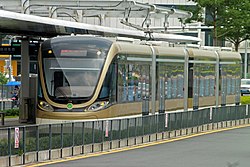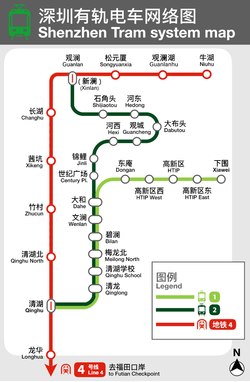Shenzhen_Tram
Shenzhen Tram
Tram system in Shenzhen, China
Shenzhen Tram is a light rail system consisting of two (formerly three) tram routes in Longhua District, Shenzhen, Guangdong, China. Construction commenced on 27 December 2013[1][2] and public testing started on 30 June 2017,[3] with the system fully opening on 28 October 2017.[4] The tram system integrates the north side of Longhua into the city's rail network and is expected to significantly ease commuting difficulties.

The initial system consists of 11.7 km (7.3 mi) and three lines. The tram links Qinghu Station on Line 4 of the Shenzhen Metro with central Guanlan, with service to Longhua areas including Automobile Industry City, Guanlan Strategic New Industries Park and the Science and Technology Service Center. It will eventually connect with Shenzhen Metro Line 4 at Xinlan Station. There are 21 stations, constructed at a cost of about 1.38 billion yuan (US$226 million). It is expected to help residents commute and relieve traffic congestion in the local area.[5][6][7] A 3.8-kilometre (2.4 mi) spur links Guanlan New Industry Park with Dahe Road. The spur is expected to cost 218 million yuan.


